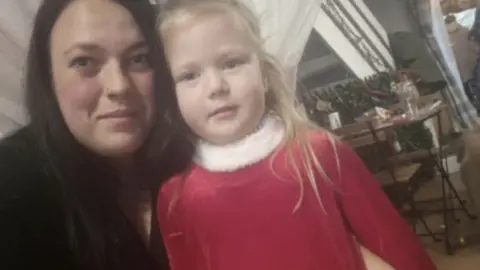Mum upset by letter calling daughter, five, overweight
 Natasha
NatashaA mum was left shocked and upset after her five-year-old daughter came home from school with a letter describing her as overweight.
Natasha, from Blaenavon, Torfaen, was informed Willow was 3ft 8in (112cm) tall and weighed about three stone 7lb (22.6kg) - this meant she was slightly above the "healthy weight" category using the body mass index (BMI) system.
Wales has a "significant problem" with childhood obesity, according to one expert, with more than 25% of children aged four to five overweight.
The Welsh government said measuring the height and weight of reception children was important to help give them the best start in life.
Despite the intentions, the categorisation shocked Natasha, as Willow takes part in gymnastics, dancing and swimming every week and has a balanced diet.
"I understand why they do it, to gather statistics for an overall population, but it's not accurate in the slightest," she said.
"It's such a demoralising approach, labelling children in such a manner, solely based on BMI.
"BMI is such an outdated approach, [providing] misleading information. There needs to be multiple factors that can represent a child's health, not just a tick-box exercise."
BMI is a measure of whether someone is a healthy weight for their height.
The NHS website states BMI scores have "some limitations" because the system measures whether a person is carrying too much weight, but not too much fat.
 Natasha
NatashaNatasha, 29, wants the system overhauled, and has started a petition calling for it to "take in the bigger picture" of lifestyle and health.
The healthcare support worker described being "so disheartened" by the letter seen by BBC Wales.
It stated calculating children's weight categories could help parents make informed choices on lifestyles.
The school had told her about health checks taking place last month, which would include eyesight and hearing assessments, as well as measurements.
Natasha believed any results would take a "holistic approach", including questionnaires sent to parents.
But the way it was done had left her worried about the "negative psychological impact" of the labels.
"I was angry and so upset," Natasha said.
"I've grown up being told I was overweight and I needed to lose weight, and I've done everything in my power to make sure Willow doesn't have any of that."
Why are children weighed at school?
The Child Measurement Scheme is Welsh government-led, and coordinated by Public Health Wales.
It sees school nursing teams measure the height and weight of every reception pupil, unless their parents opt out.
A letter is then sent to parents, explaining how they can see their child's results.
At the end of the school year, the anonymised results are analysed for trends at local health board level and national levels.
Public Health Wales said the information was used to "plan services and inform changes to help families enjoy a healthy and active lifestyle".
In the letter Natasha received, it signposted parents towards its Every Child Wales initiative, for "useful information on helping children stay fit and healthy".
 Natasha
NatashaCardiff University's Prof Adrian Edwards, who is director of the Health and Care Research Wales Evidence Centre, said the country had a "significant problem" with childhood obesity.
He added more than 25% of Welsh children aged four to five were overweight, compared to about 11% across the UK and 7% on average in other high-income countries.
"All the health problems we would recognise and understand - including mental health problems, arthritis, high blood pressure, diabetes, cancer risk and all sorts of things - they are higher risk because of overweight and obesity, which starts in childhood," he said.
He admitted some scientific research showed BMI was not always accurate.
Prof Edwards cited the example of professional rugby players who can score as obese, "but most of them are actually just full of muscle".
Another example, he said, was children's bodies changing as they grow.
However, he emphasised the need for "a balance to be struck between accuracy and consistency".
"They've been doing the same thing over 20, 30 years," he said.
"So, leaving aside the nuances of who might or might not be being incorrectly categorised at the edges, I think it's telling us something about the mainstream, the typical picture.
"The question is what you do with this information. Is it about diagnosing an individual who should then have some extra attention and support?
"Or is it actually about understanding the problem at population level, perhaps without singling out individuals?"
 Cardiff University
Cardiff UniversityThe Welsh government said measuring the height and weight of reception children was "part of our routine child development programme Healthy Child Wales which is important in improving children's health and giving them the best start in life".
A spokesperson added: "Being consistent in how school nurses measure children allows Public Health Wales to assess trends over time at a population level."
